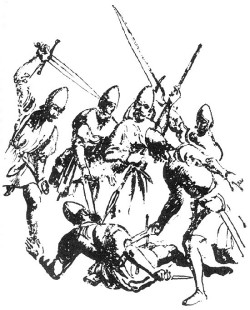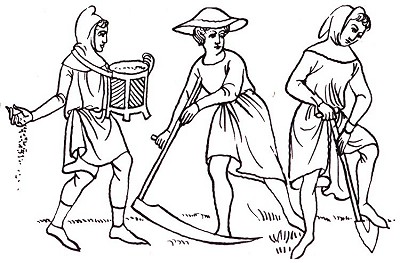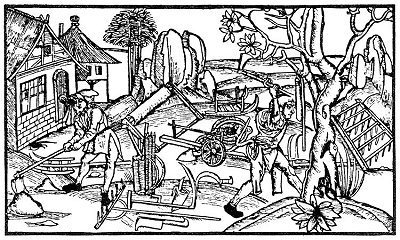The Settlement of Vyšší Brod and surroundings in second half of 13th century
 Through the Vyšší Brod
pass led an ancient trail, used already in Romish period. Through
this way were into country coming Romish businessmen and in
opposite direction the Germanic Markomans into Romish market place
in Linz. The Raffelt´s custom order from the year 906 mentions,
that through this way transported businessmen from Bohemia to the
Danubian market place slaves, horses and wax, to change it for
salt. In years 1198 and 1215 was trail called "packhorse road",
"packhorse way", or also "old way to Bohemia". In the first half of
13th century it is introduced as "antigua via", then old way, which
lead from Pasov over Helfenberg, according to which it was called
the helfenberk way.
Through the Vyšší Brod
pass led an ancient trail, used already in Romish period. Through
this way were into country coming Romish businessmen and in
opposite direction the Germanic Markomans into Romish market place
in Linz. The Raffelt´s custom order from the year 906 mentions,
that through this way transported businessmen from Bohemia to the
Danubian market place slaves, horses and wax, to change it for
salt. In years 1198 and 1215 was trail called "packhorse road",
"packhorse way", or also "old way to Bohemia". In the first half of
13th century it is introduced as "antigua via", then old way, which
lead from Pasov over Helfenberg, according to which it was called
the helfenberk way.
In places, where the provincial footpaths joined, stood ago 1259 a mercantile chapel, probably made of wood. In donation of the Cistercian cloister from 1. June 1259 is stated, that future cloister was founded "Hohennur volgariter appelato", then not far off the church in Vyšší Brod. From this description is clear, that mercantile church had stood in Vyšší Brod already in the year 1259. Exploitation of churches as centers of settlement is characteristic for the Rožmberks, how reflect the instances from Přídolí, Rožmitál and Rožmberk. Many historians show, that "in year 1259 there had already stood settlement of same name, because at the same time as cloister was the parish church found". I am not certain about a parish church in the year 1259, it seems to me rather unreal, because on July 1260 issued Vok of Rožmberk a document, where is absent a par about Vyšší Brod parish and jurisdiction of the local rector. Vice versa in document from the king Přemysl Otakar II. from 17. July 1264, where king confirmed a donation from Vok of Rožmberk, are already tithes from villages in Vyšší Brod parish.
It is clear, that at the latest from the year 1264 has been in Vyšší Brod a parish church and a rector. First known Vyšší Brod rector is namely in the year 1282 "Hainricus ludex in Altovado". The village, from which later developed a town, was not settled as planned turn, but it was an organic development, which was connected with Linz and helfenberk road. It is very probable, that in proximity of ford across the Vltava river or below mercantile chapel was already before 1259 a residence. However we don't know a protocol, that would confirm it. According to "Manual of Jan Staicz", which is the oldest Czech urbary, in the year 1278 delivered Vyšší Brod (forum) to Vyšší Brod cloister yearly 520 eggs and 16 cheeses as reduced form of stock from 16 monasterial fields (perhaps 410 hectare) of soil. Because the big farmer used to have most one field, there were in the year 1278 in Vyšší Brod minimally 16 large farms.
In years 1259 till 1262 is very often at documents from Vok of Rožmberk introduced "domunus Gerbertus" as a witness and a meaningful member of company. Gerbertus belonged among those ministeriats, whose office wasn't adherent with colonization of country, so he did not keep any estates. He appears last time in Vok´s will from 4. June 1262, when he obtained just a few horses. Analogous to other Vok´s ministeriats he stood in services of Rožmberks, but during the Jindřich of Rožmberk is with Gerber´s name linked settlement of three villages near Vyšší Brod. Their today's names are Horní and Dolní Drkolná and Herbertov. In sources from seventies and eighties years of 13th century these villages are called "minor plaga Gerberti", "Gerbechtschlag" and "tertia plaga domini Gerberti guam exstirpavid Jur". Last datum comes from the year 1281, when Gerberti is already dead and his colonization work completes unrecognized Jur. If we understand to year 1262 as "terminus post guem", so as to time, when could these three villages arise, then at the end of seventies years of 13th century it did not exceed time "na lhotě". I personally think, that "dominus Gerbertus" died already around the year 1277. To this thinking leads me a written acquisition of Jindřich of Rožmberk from the year 1277, which he issued before his campaign to Austria. He writes in it, that if he does not return, shall Vyšší Brod cloister obtain Herbertov. Document however did not take effect, because Jindřich of Rožmberk from this campaign returned. At that time was the rule, that as far as founder of village (locator) dies during the time "na lhotě", the village will get the donor of territory (donator).
In the year 1278 we learn about Dolní Drkolná from two independent sources. In confirmative document Henry of Rožmberk confirms to Vyšší Brod cloister previous donation and in addition Rožmberk adds Přísahov, Žumberk, Hrudkov and Dolní Drkolná. In already mentioned Manual of Jan Staicz is stated, that Dolní Drkolná had had in the year 1278 seven fields (perhaps 180 hectares). From the oldest Czech urbary we learn, that Vyšší Brod cloister was collecting the reduced rent at Easter and Whitsuntide from villages Kapličky, Hrudkov, Horní Přísahov, Lachovice, Horní Drkolná, Radvanov and Jan´s mill the eggs and cheeses. Hradový, Kleštín and Dolní Jílovice are for the first time in writing commemorated in testament of Vítek of Krumlov from the year 1277, when they were presented to Vyšší Brod monastery. August Sedláček hereto remarks: "even he still lived, but was so sick, that it was possible his death to foresee". As witnesses at this document were the rectors from Frymburk and from Austrian St. Osvald. Hradový probably used to be a guard point at the provincial footpath between Vyšší Brod and Tumberg (Malšín). German and Latin title (Kastlern and Častlays) only confirm it. Kleštín (in German Reith) was probably a court, which is called by A. Sedláček "Vítkův dvůr" and Klimesch "Kleškův dvůr", from which later arose Lomský dvůr. German name Reut entails croft or also a clearing.
Another crucial location of settlement round Vyšší Brod is on left shore of Vltava the foot of Kraví mountain with villages Žumberk, Přísahov, Lachovice and Hrudkov. Settlement was here probably "already long time ago", in conjunction with guard post at ford over Vltava at provincial footpath. It prompts the title Přísahov, which signified a surveillance, guard. When in the year 1278 gave Jindřich of Rožmberk Horní and Dolní Přísahov to Vyšší Brod cloister, these were already "domesticated" villages, which have had six and five fields. Fact that there was fertile soil shows a German title Schonbub, then beautiful field. Sources introduced, that Lachovice is for the first time commemorated in writing in the year 1338. I would like to correct this datum, because the oldest Czech urbary from the year 1278 shows Lachovice among places, which were paying reduced natural dues to Vyšší Brod monastery. Yearly hundred eggs and five cheeses. The amount of fields does not however appear here. By simple analogy it is possible to determine, that it was five fields. As far as the writer remembered to write down this datum, it is possible, that the field area was from the beginning larger and the settlement could not deliver 20 eggs and one cheese from the field. I would rather incline to this variant.
The next village Žumberk, which is commemorated already in the year 1259, then at the time of cloister´s establishment. Its German title Sunnenberg entails "sunny place". The village belonged to Rožmberk castle and in the year 1278 Jindřich of Rožmberk gave it together with Přísahovs and Hrudkov to Vyšší Brod cloister. While I was able to find Hrudkov and both Přísahovs in urbary from the year 1278, Žumberk is here absent. About one hundred years later, in the year 1379 Žumberk in Rožmberk´s urbary appears. So I have doubts about an actual transmission. Monasterial chronicler Kaidl writes, that "Sonnberg was by heel Otto I. lost". When and behind what circumstances does not stay here.
As I have already several times presented, Hrudkov (called in year 1277 Rykchendorf) was in the year 1278 once for all passed to Vyšší Brod monastery. Already in the year 1277 referred in his testament Jindřich of Rožmberk villages Žumberk, Horní and Dolní Přísahov and Hrudkov to cloister, but this presentation was certified in the year 1278 "from sympathy upon the lack". In this year had the cloister to give into pledge of certain Sibota from Sprinzenstein unrecognized estates. Hrudkov had in the year 1278 already been a large village and in urbary from the same year is stated, that it had ten fields. From this size is possible to say, that Hrudkov was founded sometimes during years 1250 till 1260, so probably before the cloister.
Another group of settlements round Vyšší Brod in second half of thirteenth century was round the mountain Hradiště, where certainly was a guard post, from which could be observed both provincial footpaths approaching to Vyšší Brod. I personally think, that guard duty was carried here "from time out of mind" by citizens from Studánky. Title of this village, which is in German Kaltenbrunn, probably comes from a phrase "zur kalten quele", what means near a cold fountain or near a cold spring. In the year 1278 Studánky did not belong to Vyšší Brod monastery. It was an possession of the Rožmberks and competed with Vyšší Brod over a provincial toll. Whose property were Studánky and Vyšší Brod before the Rožmberks came is not clear. Also the village Bystrá (Schild) in the year 1278 belonged to the Rožmberks, which doubtlessly confirms an entry "villa Schillete Hemdrici de Rosemberch" in monasterial papers. Its name got Bystrá according to brook, upon which it was found. The German name had primary form Schilte, which can be translated as a penthouse. Opposite to previous two communities belonged Radvanov, in German Raifmass, already in the year 1278 to the Cistercian cloister. It is stated in already mentioned oldest urbary in Czech lands in its list of natural dues. It was a small village, perhaps just two yards with two fields, which arose not long time ago and was certainly "na lhotě". German title can be translated as circular meadow.
To monasterial estate in the year 1278 belonged also "Jan´s mill", without better known location. It is possible think, that it was a predecessor of White mill. It was located near the provincial footpath and in proximity of ford, so at a point, which was almost ideal. Other mills were established on the Vltava river later and in the thirteenth century would be illogical to build mills out of Vltava river in region Vyšší Brod. It was a riverine mill, "screwed, built on nettles", so on posts embedded "partly to a shore, partly into water". The hackney miller laboured "for the fourth rap", what meant, that every fourth rap was a transfer to owner. Whether the Rožmberks built it or cloister is debatable, I think it was the Rožmberks, because cloister was then poor and had troubles with construction. Anyway to mill belonged one field, its natural due was 20 eggs and one cheese yearly.
From the year 1278 till the end of thirteenth century are round Vyšší Brod commemorated another two settlements. Near Vyšší Brod arose Pošlák. Till this time was believed, that Pošlák is for the first time recorded in the year 1400. I however will correct this statement according to analysis of Manual of Joan Staicz. In so-called "Urbary Vyšší Brod II." from the year 1290 is except for Slupečná, Přední Kruhová and undefine Pisenrait mentioned even Pošlák, introduced here as Poscheschlag, what meant the clearing of Poš. The name probably came from Upper-Austrian pronunciation of the names Boš, which was short form of Bohuslav. So we know, that in Pošlák was a locator someone called Bohuslav, who directed a construction of this new settlement. We also know the name of donator and locator of the last settlement near Vyšší Brod. Jindřich of Rožmberk entrusted someone called Gusner in 1293, to establish "villa in Waldawe". Vadov, Waldau was hidden in grove between Jezevčí hill and Hradiště, it is not clear to me why was new settlement placed right here, amid the woods. Even a German title of settlement originates from Waldouwe, what means the wood spirit.
(fs)
Further information :
History
of the Vyšší Brod Region
Vyšší
Brod
The
Rosenbergs
The
Manual of Joan Staicz in Vyšší Brod monasterial library
Vyšší
Brod Monastery
Malšín
a Tumberg



